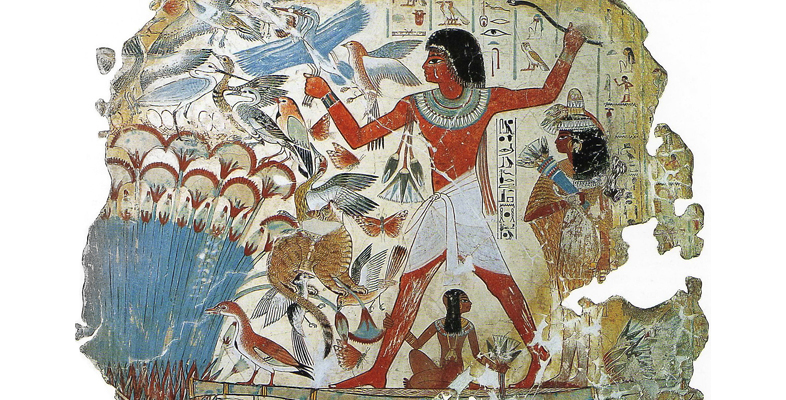3.2 Reconstructions
Viewing the produce of the estate
Look first at the speculative reconstruction incorporating the three surviving ‘Viewing the produce of the estates’ fragments (Figure 16).
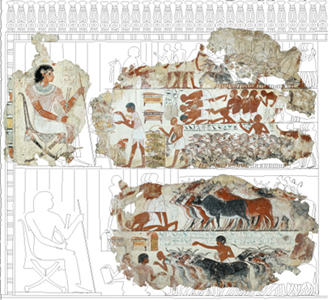
What can you say now about the overall construction of this scene and its meaning?
It is made up of two registers of equal height, each taking up approximately half the height of the wall. This area is surrounded by a coloured block border that frames the whole picture space, only a tiny fragment of which survives at the left-hand edge. There is also an elaborate, rather abstract decorative frieze along the top. Each of these main registers is subdivided into narrower bands: two in the lower fragment, with a rather more confused situation in the top one – for there, the lower of the two sub-registers is itself further subdivided. The overall effect is of several layers, perhaps five in all, with nearly all of the actors facing to the left.
As we have learned from the offering and banquet scenes, the various activities taking place are dedicated to Nebamun – who is represented by two large-scale figures at the left-hand end of the picture. Only one of these Nebamun figures has survived.
The overall scene affords us a glimpse into the dynamic of ancient Egyptian productive life. The fruits of agricultural production are brought before the overseer for annual review. The agricultural workers show extreme respect for the overseer, reflecting the hierarchical nature of Egyptian society. A pivotal role is held by the scribes, demonstrating the power of literacy to the functioning of Egyptian society.
Agricultural scenes
Now consider the reconstruction of the ‘Agricultural scenes’ fragments (Figure 17).
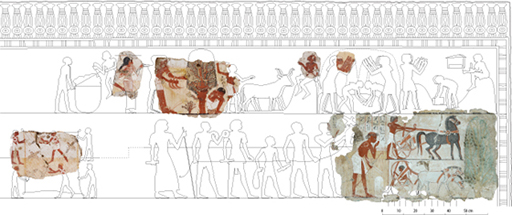
What is happening in this scene, somewhat in the manner of a strip cartoon, is that to the left in one ‘frame’ Nebamun and his team are out in the grain fields carrying out an inspection with the help of the farmer, while to the right their drivers have parked the chariots in the shade of a large sycamore tree at the edge of the field, and are waiting for the officials to complete their inspection – most likely before either heading off to another farm, or if it is late in the day, back to the ‘office’ (i.e. the administrative buildings in the temple complex) at Thebes.
Now watch this video in which Richard Parkinson and Paul Wood talk about the ‘Agricultural scene’.
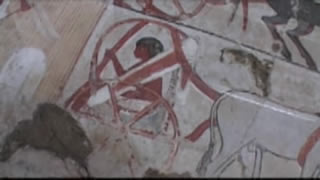
Transcript
Offering bringers
Finally, consider this reconstruction of the ‘Offering bringers’ (Figure 18).
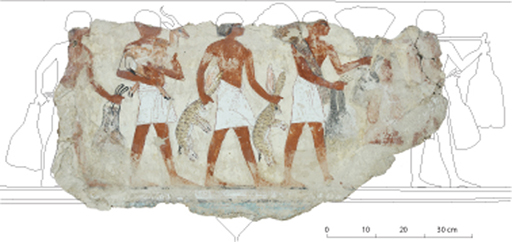
These animals are part of another gift of offerings. The difference here is that whereas in the other scenes it is the produce of the farm that is being brought forth, here in addition to the products of harvest – the sheaves of grain – these animals are representatives of the wild, captured out in the desert, which is by implication now also brought within the purview of Nebamun, Grain-accountant in the Temple of Amun.
Now watch this video in which Richard Parkinson and Paul Wood talk about ‘Offering bringers’ scene.
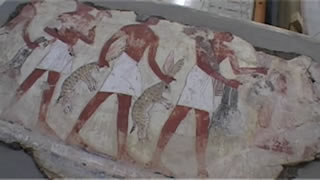
Transcript
In conclusion, Nebamun was an administrator – quite a well-off one. His memorial chapel showed both sides of his life, at leisure and at work: a banquet for friends and relatives, and these scenes of animal husbandry and the produce of the fields, not least the grain which was the staple of Egyptian life. One of the defining features of ancient Egyptian society, perhaps the single most important one that made the civilisation what it was, was its bureaucracy: the multiple layers of efficient administration that held the system together. This was a largely pre-industrial, agrarian society, a barter economy moreover. So these scenes give us, in effect, a glimpse of the sharp end of that system, out in the fields, recording the information about the produce of the estates that Nebamun and other officials like him in the great Temple of Amun at Thebes would then use to organise the community’s spiritual and temporal life. If these encounters had not occurred, if those records had not been kept, if the farmers had not kissed the ground and if Nebamun had not sat on his folding chair as the animals squawked and bellowed and the dust rose, there would not have been any banquets and floral collars and exquisite costumes, nor indeed any temples to raise and tomb-chapels to decorate.
